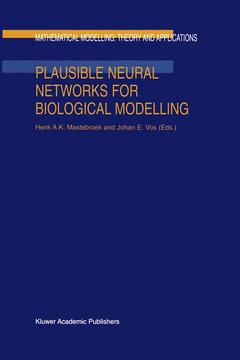Plausible Neural Networks for Biological Modelling, 2001 Mathematical Modelling: Theory and Applications Series, Vol. 13
Langue : Anglais
Coordonnateurs : Mastebroek H.A., Vos J.E.

The expression 'Neural Networks' refers traditionally to a class of mathematical algorithms that obtain their proper performance while they 'learn' from examples or from experience. As a consequence, they are suitable for performing straightforward and relatively simple tasks like classification, pattern recognition and prediction, as well as more sophisticated tasks like the processing of temporal sequences and the context dependent processing of complex problems. Also, a wide variety of control tasks can be executed by them, and the suggestion is relatively obvious that neural networks perform adequately in such cases because they are thought to mimic the biological nervous system which is also devoted to such tasks. As we shall see, this suggestion is false but does not do any harm as long as it is only the final performance of the algorithm which counts. Neural networks are also used in the modelling of the functioning of (sub systems in) the biological nervous system. It will be clear that in such cases it is certainly not irrelevant how similar their algorithm is to what is precisely going on in the nervous system. Standard artificial neural networks are constructed from 'units' (roughly similar to neurons) that transmit their 'activity' (similar to membrane potentials or to mean firing rates) to other units via 'weight factors' (similar to synaptic coupling efficacies).
I Fundamentals.- 1 Biological Evidence for Synapse Modification Relevant for Neural Network Modelling.- 2 What is Different with Spiking Neurons?.- 3 Recurrent Neural Networks: Properties and Models.- 4 A Derivation of the Learning Rules for Dynamic Recurrent Neural Networks.- II Applications to Biology.- 5 Simulation of the Human Oculomotor Integrator Using a Dynamic Recurrent Neural Network.- 6 Pattern Segmentation in an Associative Network of Spiking Neurons.- 7 Cortical Models for Movement Control.- 8 Implications of Activity Dependent Processes in Spinal Cord Circuits for the Development of Motor Control; a Neural Network Model.- 9 Cortical Maps as Topology—Representing Neural Networks Applied to Motor Control: Articulatory Speech Synthesis.- 10 Line and Edge Detection by Curvature—Adaptive Neural Networks.- 11 Path Planning and Obstacle Avoidance Using a Recurrent Neural Network.
Date de parution : 10-2012
Ouvrage de 262 p.
15.5x23.5 cm
Date de parution : 09-2001
Ouvrage de 262 p.
17x24.4 cm
Thèmes de Plausible Neural Networks for Biological Modelling :
Mots-clés :
Nervous System; algorithms; biology; neurons; simulation; spiking neurons; topology
© 2024 LAVOISIER S.A.S.



